|
Model
Aircraft (fixed wing) – Jetex 50
Click on any image to view or download the construction plan.
Arrow 50
by Ian Dowsett

Click image to view or download full-size plan
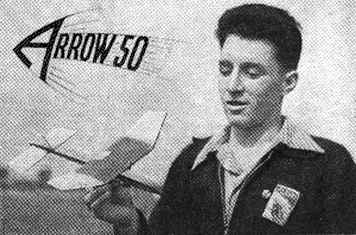  One of the best – if not the best – of the classic
Jetex 50 designs.
One of the best – if not the best – of the classic
Jetex 50 designs.
Designed by the redoutable Ian Dowsett (seen in the photograph holding
the prototype), the plan was published in the April 1953 issue of
Aeromodeller.
Highly recommended!
Thanks to Howard Metcalfe for sharing this plan.
|

Fizzel Fazzel
by Bob Wilson

Click image to view or download full-size plan
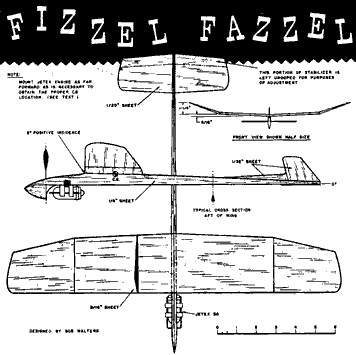  Fizzel Fazzel is straightforward to build and is described by Mark Petrovich as a "lady of the air".
Here's the account of a "fantastic flight" Mark made in March 2003,
using a Jet-X 50 motor, which he managed to fire on his third attempt:
Fizzel Fazzel is straightforward to build and is described by Mark Petrovich as a "lady of the air".
Here's the account of a "fantastic flight" Mark made in March 2003,
using a Jet-X 50 motor, which he managed to fire on his third attempt:
"I was on the top of a hill about 8 feet above the field elevation. The model flew away
from me and never descended. It climbed true and hesitated for a second about 50 feet
away from me. It then got a second wind, pellet two no doubt, and continued climbing away.
It turned a slow arc to the right and seemed to slow down a bit. Then the model lurched
forwards more and I heard the mild report as the third pellet began burning.
"With heart racing, I watched as the model continued to turn right and climb upwards.
Progress forwards slowed a bit into the wind until the model, its fuel exhausted,
settled into a glide. It had reached an estimated 40 feet above the point of launch
and had executed a 360° turn with an arc radius of about 30 feet. It continued to glide
until it ran into some trees about 30 feet up whereupon the wing was violently disengaged
from the fuselage. The fuselage fell independently all the way to the ground and the wing
tumbled through the trees to rest in some leaves.
"I walked about 400 feet through mud, across an embankment and found all three parts.
The fin had been torn off in the fall so I carried a total of four pieces to the car.
Ecstatic, I called my son, who thinks that flying things are my drug addiction,
and told him the news of this fantastic flight."
|

Fizzle XIII
by D. J. Lindley

Click image to view or download full-size plan
  The Fizzle XIII comes from the Zaic Zaic Model Aeronautic Year Book of 1964-65 yearbook. We're indebted to
Carlo Godel who has kindly contributed a beautifully clear redrawing of the plan especially
for this archive.
The Fizzle XIII comes from the Zaic Zaic Model Aeronautic Year Book of 1964-65 yearbook. We're indebted to
Carlo Godel who has kindly contributed a beautifully clear redrawing of the plan especially
for this archive.
Of the full-size plan, Carlo says,
"It is drawn at 120 dpi for size, on a 10" x 16" format for 11" x 17" sheet".
To quote the original designer, Fizzle XIII was "13th in a series of essentially identical
models built since 1946 and all lost OOS before fuel was used up".
|

Vulture
by Bill Dean

Click image to view or download four-page article with
full-size plan
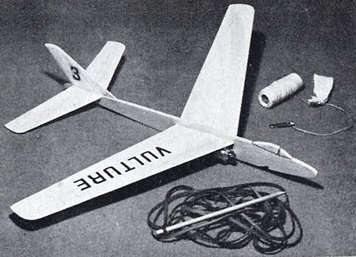  The Vulture comes from "Bill Dean's Book of Balsa Models".
The Vulture comes from "Bill Dean's Book of Balsa Models".
Bill describes it as "a graceful semi-scale fighter", with the option of a catapult launch. Brian Benson recommends "building the catapult as this extends the flight".
Peter Tolhurst has these recommendations: "Heed the instructions and use medium/hard, if not hard, balsa for the fuselage. Mine wasn't hard enough, and the model was prone to snapping the fuselage either side of the wing depending on the type of 'hard' landing. Also the motor mounting plate needs to be strengthened for the Jet-X mount."
We have the complete article, with a full-size plan,
available for download.
Thanks to Brian Benson for sharing this article.
|

Good Times
by Bob Stalick

Click image for full-size plan
  Bob writes "Three models have been built since our move into apartment living, and they
have all performed admirably. I don't think the D/T system shown on the
plans is absolutely necessary, since the model is really easier to build
than a hand launch glider, and the D/T system simply congests the model …
but they do thermal since the weight is nearly nothing.
Bob writes "Three models have been built since our move into apartment living, and they
have all performed admirably. I don't think the D/T system shown on the
plans is absolutely necessary, since the model is really easier to build
than a hand launch glider, and the D/T system simply congests the model …
but they do thermal since the weight is nearly nothing.
"The plans are self-explanatory, but a couple of notes are in order. Be sure
to include the spruce backbone on the fuselage, or else you'll be troubled
with fuselage breakage. Cover the wing with tissue and apply two coats of
thinned nitrate dope. Dope the entire fuselage and stab with 2 coats of
nitrate. It would help to glue a piece of aluminum foil under the fuselage
just behind the engine to keep this area from getting charred by the blast
(?). Be sure to wash in the wing as specified. If in doubt, put in more wash
in than you think it will need. Glide is controlled by excessive stab tilt
to the right and climb is controlled by offsetting the rudder to the right.
Engine thrust should be straight with no offsets. When ready to fly, the
entire ship should weigh in at around 20 grams with motor loaded. That's
about .8 ounces, and with a good Jetex burn giving out around .6 oz. of
thrust, the model really hauls."
Thanks to Doug Foster for sharing this plan
from 'Model Builder Magazine'.
|

|
"The
Executive"
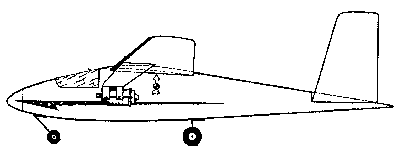 
This twin Jetex 50 motor
freeflight airplane offers good
performance and rugged construction.
It's simple, light, stable in flight,
and realistic looking, with a slow
floating glide. It is capable of a
minimum of 100 ft [30 m] altitude under
power, and a long duration in its
glide. The model is built up on a
backbone, insuring perfect alignment
and giving shape in final assembly.
The fuselage bottom is cut from 1/32"
[0.8 mm] sheet with lengthwise grain;
wheels are of balsa, hardwood, or
rubber; leading edge of wing is 1/8" [3
mm] square pine; finish recommended is
two coats of clear dope mixed with a
little castor oil to prevent warping.
Balance should not require added
weight, but if needed, balance at wing
tips and add bits of modelling clay to
nose or tail as
required.
Under power, this plane will
perform at high speeds--use only 1/2
fuel pellet in each Jetex unit for
first flights. Test the model
thoroughly, adjusting for a slight
right or left turn. Use SLIGHT
adjustments, as the model flies fast
under power, and any slight
maladjustment is greatly amplified.
Have a friend help with ignition. Wait
until you can feel equalized thrust
from both units. DO NOT attempt to fly
with only one motor operating. Note:
Downthrust should permit adequate power
trimming if needed. This plan was
donated by Fred Rash. Click the
thumbnail to see (or download) the
full-size, 1:1 scale
plan.
Note
that this plan has 3
images: Part 1, Part 2, Part 3
|

|
"Ski-Dart"
 
Yet another twin Jetex 50
motor freeflight, this time a true
seaplane. Design is by Lawrence H.
Conover, appearing in American Modeler,
Nov 1957 (p29). According to that
article:
Convair's experimental Sea
Dart was probably the most unusual
seaplane ever to ROW. Your twin jet
model, the SKI-DART, is a going
machine. There is exciting realism in
the long takeoff run . . . the sudden
dip earthward as the lift breaks down
(a basic characteristic of delta wings
due to a flow transition, even on full
scale aircraft) . . . a bounce back
into the air, both jets blasting ...
fast low-angle climb to altitudes of
100' . . . smooth flare-over as power
dies ... a fighter-like glide to the
for end of the field.
This is an easy model to
construct. First digest the plans
thoroughly. Make wing board a bit
oversized; do not lay out on wax paper;
put glue on both edges of three-inch
sheets to be joined; stick together in
midair; lay on flat work-bench and rub
in glue at joint; let dry about 3
minutes. Wiggle loose and turn over;
add small amount of glue and rub in;
let dry and then continue in same
manner. When dry, draw delta wing shape
and cut with a sharp razor blade, using
a straight edge for accuracy. Add
leading edge strips; taper completed
wing to 1/16" thickness at tips; don't
forget reflex section on lower trailing
edge.
Do all colored-pencil
decoration before assembly; do not
"paint" a flying model. The skis and
Struts, as a completed unit, are
cemented into slots in fuselage; double
coat with glue.
Flying is easy if care is
taken. Get a straight glide or a very
large circle. The ship will probably
have a tendency to turn in one
direction when thrown hard on a hand
glide. Note this highspeed turning,
then always light up the motor that is
on the inside of that circle first.
Thrust forces act about the C.G. and
this little trick will keep your model
in a safe flight pattern. If you pull
fuse wires when the charges ignite (to
prevent backfiring and loss of power)
wet your fingertips
first!
Your SKI-DART will take off
any surface it can skid on. This model
was designed oversize and heavy for
easy flying. If you have success with
this version, you might wish to try a
lightweight ship using thinner and
lighter balsa. But be careful--it's
hot!
|

|
"Floater"
 
Another all balsa, easy to
build from scratch plane, also designed
for a Jetex 50 size motor.
Click the thumbnail to see (or download) the
full-size, 1:1 scale plan.
|

|
"Small
Wonder"
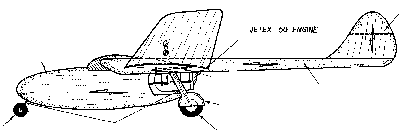 
This fine little plane is all
balsa, and easy to build from scratch.
It is designed for a Jetex 50 size
motor. The plan was donated by David
Fritchman, of New Mexico. Click the
thumbnail to see (or download) the
full-size, 1:1 scale plan.
|

|
"Blowtorch"
 
This plane is a Jetex 50
trainer. Plan has details for a
higher-powered version as well. Click
the thumbnail to see (or download) the
full-size, 1:1 scale plan.
|

|
"Yak 25"
 
This is a French designed
Jetex 50 airplane. Click the thumbnail
to see (or download) the
full-size, 1:1 scale plan.
|

|
"Apparition"
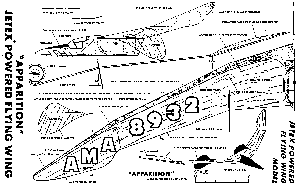 
This strange, swept-wing bird
uses a Jetex 50 motor. Click the
thumbnail to see (or download) the
full-size, 1:1 scale plan.
|

|
Jetex Delta by Paul Del Gatto
  This flying wing, another imaginative Del Gatto design, was characterised in Vic Smeed's Flying Models Favourites of the Fifties (1988) as "the sort of experimental model possible with the Jetex 50 or 35". This flying wing, another imaginative Del Gatto design, was characterised in Vic Smeed's Flying Models Favourites of the Fifties (1988) as "the sort of experimental model possible with the Jetex 50 or 35".
Plan originally published in Model Airplane News, April 1957.
Click image to
see (or download) the
full-size,
1:1 scale plan.
|

The
following plans were all designed to meet the requirements of the PAA-Load contest, Junior
division. One of those requirements was that the model include a dummy pilot, hence the
addition of a canopy to each of these models.
|
Dummy Dip 50 by Charles Sotich
for the Junior Jet
PAA-Load Class
  The 'Dummy Dip 50' has a pylon-mounted motor and a sheet balsa wing.
The 'Dummy Dip 50' has a pylon-mounted motor and a sheet balsa wing.
Plan from Zaic Model Aeronautic Yesr Book, 1959-61.
Click image to see (or
download) the plan.
|

|
Junior Jet PAA-Load by Paul H.
Osborne – Junior Jet PAA-Load class
record holder
  This design held the
record for a flight in its class of 6 min. 6 sec. and, over 30 official flights, recorded an average of 1 min. 8 sec. Construction is simple, with sheet balsa flying surfaces. The pylon-mounted motor "was moved ot present location from fuselage bot. because of finger burn during launch"! This design held the
record for a flight in its class of 6 min. 6 sec. and, over 30 official flights, recorded an average of 1 min. 8 sec. Construction is simple, with sheet balsa flying surfaces. The pylon-mounted motor "was moved ot present location from fuselage bot. because of finger burn during launch"!
Plan from Zaic Model Aeronautic Yesr Book, 1959-61.
Click
image to see (or download) the
plan.
|
|